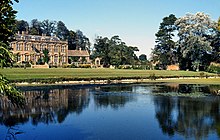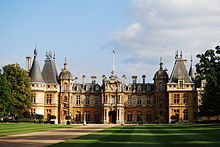English country house

An English country house is a large house or
With large numbers of indoor and outdoor staff, country houses were important as places of employment for many rural communities. In turn, until the
While a château or a Schloss can be a fortified or unfortified building, a country house, similar to an Ansitz, is usually unfortified. If fortified, it is called a castle, but not all buildings with the name "castle" are fortified (for example Highclere Castle in Hampshire).
Stately homes of England
The term stately home is subject to debate, and avoided by historians and other academics. As a description of a country house, the term was first used in a poem by Felicia Hemans, "The Homes of England", originally published in Blackwood's Magazine in 1827. In the 20th century, the term was later popularised in a song by Noël Coward,[4] and in modern usage it often implies a country house that is open to visitors at least some of the time.[citation needed]

In England, the terms "country house" and "stately home" are sometimes used vaguely and interchangeably; however, many country houses such as
Evolution
The country houses of England have evolved over the last five hundred years. Before this time, larger houses were usually fortified, reflecting the position of their owners as
It was during the second half of the reign of

Some of the best known of England's country houses were the work of only one architect/designer, built in a relatively short, particular time: Montacute House, Chatsworth House, and Blenheim Palace are examples. While the latter two are ducal palaces, Montacute, although built by a Master of the Rolls to Queen Elizabeth I, was occupied for the next 400 years by his descendants, who were gentry without a London townhouse, rather than aristocracy. They finally ran out of funds in the early 20th century.
However, the vast majority of English country houses, often owned at different times by gentlemen and peers, are an evolution of one or more styles with facades and wings in different styles in a mixture of high architecture, often as interpreted by a local architect or surveyor, and determined by practicality as much as by the whims of architectural taste. An example of this is Brympton d'Evercy in Somerset, a house of many periods that is unified architecturally by the continuing use of the same mellow, local Ham Hill stone.
The fashionable
Sizes and types
Wealthy and influential people, often bored with their formal duties, go to the country in order to get out of London, the ugliest and most uncomfortable city in the world; they invented the long week-end to stay away as long as possible. Their métier is politics; they talk politics; and they make politics, quite spontaneously.
— John Gunther, 1940[8]
There are no written terms for distinguishing between vast country palaces and comparatively small country houses; the descriptive terms, which can include castle, manor and court, provide no firm clue and are often only used because of a historical connection with the site of such a building.[citation needed] Therefore, for ease or explanation, Britain's country houses can be categorised according to the circumstances of their creation.[by whom?]
Power houses

The great houses are the largest of the country houses; in truth palaces, built by the country's most powerful – these were designed to display their owners' power or ambitions to power.[9] Really large unfortified or barely fortified houses began to take over from the traditional castles of the crown and magnates during the Tudor period, with vast houses such as Hampton Court Palace and Burghley House, and continued until the 18th century with houses such as Castle Howard, Kedleston Hall and Holkham Hall.[10] Such building reached its zenith from the late 17th century until the mid-18th century; these houses were often completely built or rebuilt in their entirety by one eminent architect in the most fashionable architectural style of the day and often have a suite of Baroque state apartments, typically in enfilade, reserved for the most eminent guests, the entertainment of whom was of paramount importance in establishing and maintaining the power of the owner. The common denominator of this category of English country houses is that they were designed to be lived in with a certain degree of ceremony and pomp. It was not unusual for the family to have a small suite of rooms for withdrawing in privacy away from the multitude that lived in the household. These houses were always an alternative residence to a London house.
During the 18th and 19th centuries, for the highest echelons of English society, the country house served as a place for relaxing, hunting and running the country with one's equals at the end of the week, with some houses having their own
The country house, however, was not just an oasis of pleasure for a fortunate few; it was the centre of its own world, providing employment to hundreds of people in the vicinity of its
As a result of the aristocratic habit of only marrying within the aristocracy, and whenever possible to a sole heiress, many owners of country houses owned several country mansions,[13] and would visit each according to the season: Grouse shooting in Scotland, pheasant shooting and fox hunting in England. The Earl of Rosebery, for instance, had Dalmeny House in Scotland, Mentmore Towers in Buckinghamshire, and another house near Epsom just for the racing season.[14] For many, this way of life, which began a steady decline in 1914, continued well into the 20th century, and for a few continues to this day.
Minor country houses
In the second category of Britain's country houses are those that belonged to the squirearchy or landed gentry. These tend either to have evolved from medieval hall houses, with rooms added as required, or were purpose-built by relatively unknown local architects. Smaller, and far greater in number than the "power houses", these were still the epicentre of their own estate, but were often the only residence of their owner.
However, whether the owner of a "power house" or a small manor, the inhabitants of the English country house have become collectively referred to as the ruling class, because this is exactly what they did in varying degrees, whether by having high political influence and power in national government, or in the day-to-day running of their own localities or "county" in such offices as
The Country house mystery was a popular genre of English detective fiction in the 1920s and 1930s; set in the residence of the gentry and often involving a murder in a country house temporarily isolated by a snowstorm or similar with the suspects all at a weekend house party.
Victorian houses

Following the
Decline
The slow decline of the English country house coincided with the rise not just of taxation, but also of modern industry, along with the agricultural depression of the 1870s. By 1880, this had led some owners into financial shortfalls as they tried to balance maintenance of their estates with the income they provided. Some relied on funds from secondary sources such as banking and trade while others, like the severely impoverished Duke of Marlborough, sought to marry American heiresses to save their country houses and lifestyles.[17]
The ultimate demise began immediately following
Despite this slow decline, so necessary was the country house for entertaining and prestige that in 1917
Today
Today, many country houses have become hotels,[18] schools, hospitals and museums, while others have survived as conserved ruins, but from the early 20th century until the early 1970s, hundreds of country houses were demolished. Houses that survived destruction are now mostly Grade I or II listed as buildings of historic interest with restrictions on restoration and re-creation work. However such work is usually very expensive.
Although the ownership or management of some houses has been transferred to a
The lifestyles of those living and working in a country house in the early 20th century were recreated in a
See also
- Banqueting house
- British country house contents auctions
- Country house poem
- Country house theatre
- English country houses with changed use
- Estate houses in Scotland
- Estate (land)
- Great house
- Historic house
- English landscape garden
- Licence to crenellate
- List of castles in England
- List of country houses in the United Kingdom
- List of English Heritage properties
- List of historic buildings of the United Kingdom – country house architectural periods and styles
- List of National Trust properties in England
- Manor house
- Mansion
- Prodigy house
- Roman villa
- Servants' quarters
- Treasure Houses of England
Media
References
- ^ As documented in The Purefoy Letters, 1735–53 by L. G Mitchell.
- ^ The lions and loins of Longleat Archived 29 June 2011 at the Wayback Machine The Sunday Times Retrieved 18 February 2011
- ^ New Scientist 2 Dec 1982 Archived 21 May 2016 at the Wayback Machine Retrieved 18 February 2011
- ^ "The Stately Homes of England" by Noël Coward (1938) was featured in his musical "Operette", which premiered in the same year.
- ^ Girouard, p.
- ^ Harling, p 1–16.
- ^ Country Life, Saturday, 7 May 1927.
- ^ Gunther, John (1940). Inside Europe. New York: Harper & Brothers. p. 287.
- ^ Girouard, p2-12.
- ^ Girouard, p. 2-12.
- ^ "Rise and Fall of the English Stately Home". Historic UK. Retrieved 20 October 2022.
- ^ Robinson, 72-79, 83-85, 166-167, 181-187
- ^ Worsley, p. 10.
- ^ McKinstrey, p181.
- ^ Girouard, p2, describes a squire as "like a little king in his village.
- ^ a b Hall, p25.
- ^ Stuart, p. 135.
- ^ "Staying at an English Manor House". AGLAIA Magazine. 6 November 2018. Archived from the original on 19 January 2019. Retrieved 19 January 2019.
- ^ "Large Houses to Rent for Parties". Mansions & Large Houses for Rent for Parties & Weddings UK. 9 June 2012. Archived from the original on 8 February 2021. Retrieved 22 March 2017.
- ^ "Downton Abbey on MASTERPIECE on PBS". PBS. Archived from the original on 26 October 2019. Retrieved 29 October 2019.
Sources and further reading
- Airs, Malcolm (1975). The Making of the English Country House, 1500–1640. London: Architectural Press. ISBN 0-85139-378-0.
- Coutu, Joan, et al. eds. Politics and the English Country House, 1688–1800 (McGill-Queen's University Press, 2023) online book review
- ISBN 0-300-02273-5. Details the impact of social change on design.
- Hall, Michael (2009). The Victorian Country House. London: Aurum Press Ltd. ISBN 978-1-84513-457-0.
- ISBN 0-7195-5567-1.
- Kroll, Alexander, ed. (1969). Historic Houses: Conversations in Stately Homes. Discussions with ISBN 0-900303-05-0.
- ISBN 0-7509-1678-8. Gives much detail of how a smaller country house operated in the early 20th century.
- ISBN 1-85145-551-5.
- ISBN 0-7195-6586-3.
- Murdoch, Tessa (2006). Noble Households: Eighteenth-Century Inventories of Great English Houses. A Tribute to John Cornforth. Cambridge: ISBN 978-0-9524322-5-8.
- Robinson, John Martin, The English Country Estate, 1988, Century Hutchinson/ National Trust, ISBN 0712622756
- Stuart, Amanda Mackenzie (2005). Consuelo and Alva Vanderbilt: The Story of a Daughter and Mother in the Gilded Age. New York: Harper Perennial. ISBN 978-0-06-093825-3.
- ISBN 1-85410-820-4.
External links
- The National Trust – England, Wales, & Northern Ireland
- The National Trust for Scotland
- English Heritage
- Historic Houses Association Archived 24 February 2018 at the Wayback Machine
- Hudson's Historic Houses and Gardens – Hudson's list of 2,000 properties open to the public
- The DiCamillo Companion to British & Irish Country Houses Archived 9 May 2008 at the Wayback Machine
- Lost Heritage – A Memorial to the Lost Country Houses of England

